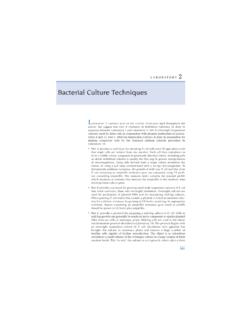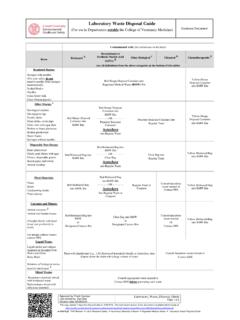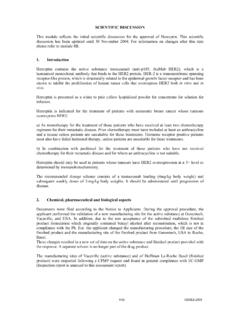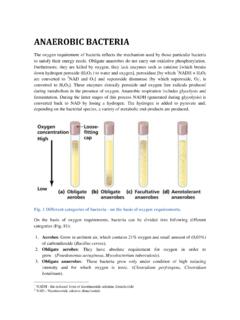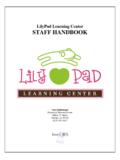Transcription of Laboratory Biological Waste Disposal Guidance
1 1 Laboratory Biological Waste Disposal Guidance2016 Laboratory Biological Waste Disposal Guidance2 Laboratory Biological Waste Disposal Guidance2016 IntroductionThe Disposal of Biological Waste is regulated by the Health and Safety Executive, the EnvironmentAgency, the Human Tissue Authority and in some instances the Home aim of this Guidance is to provide information to enable you to dispose of Biological wastesafely and comply with the Environmental Permitting (England and Wales) Regulations 2010. Itshould be read together with the project risk / COSHH / GMO assessment which should state howwaste will be treated for Disposal and the Laboratory Waste Disposal is important that the information in this Guidance is followed both for your safety and for thesafety of you have any doubts about how to deal with your Waste you can speak your line manager.
2 Amember of the core facilities team or a member of the SHE associated with disposing of Laboratory to destroy pathogenic to destroy genetically modified of material from sharps of material from split Waste injury due to needles of other items not being placed in the correct Waste being stockpiled within to contractor staff handling that could cause rejection of the Waste by the Waste being placed in the wrong and sharps boxes being mixed in the wrong being over-filled3 Laboratory Biological Waste Disposal Guidance2016 Waste Disposal ProcedureThe most important step in the Disposal of your Waste is the correct identification if the Waste typeand determining whether it needs to be treated prior to the Waste Anatomical wasteHuman cell linesHuman Biohazard Group 1 Human Biohazard Group 2 Human Biohazard Group 3 Genetically Modified OrganismsSpecified Animal Pathogen Order (SAPO) organismsNon-human Cell LinesSoft plastic pipettesHard plastic pipettesTissue culture plasticsElectrophoresis / Western blotting the Waste need to be destroyed?
3 Waste that contains or has been contaminated by the following should Anatomical wasteHuman cell linesHuman Biohazard Group 2 Human Biohazard Group 3 Genetically Modified OrganismsOrganisms listed on Schedule 1 of the Specified Animal Pathogen the appropriate destruction methodAutoclaving at 134oCValidated chemical destruction ( Virkon, Bleach, NaDCC) the appropriate Disposal method4 Laboratory Biological Waste Disposal Guidance2016 Non-sharp wasteOffensive Waste Tiger stripped bag or Bio-binUntreated infectious Waste containing chemicals Yellow Waste bag or Bio-binUntreated infectious Waste not containing chemicals Orange Waste bag or Bio-binCytotoxic / Cytostatic Waste Purple bag or Bio-binAnatomical Waste Red lidded sharps box or Bio-binSharp wasteSharps hard plastic pipettes Waste Yellow sharps box or Bio-binSharps Cytotoxic / Cytostatic Purple lidded sharps box or Bio-binSharps used to dissect anatomical material Yellow sharps box or Bio-bin5 Laboratory Biological Waste Disposal Guidance2016 Destruction MethodsThe following methods of disposing of Biological Waste are available within SGULA utoclaving on a destruction cycle at 134oCChemical treatment using a validated
4 DisinfectantAutoclavingAll Biohazard group 3 organisms and Genetically Modified Organisms (GMO s) at class 3 must bedestroyed by autoclaving at 134oC. It is also preferable that Biohazard group 2 and GMO class 2organisms are treated at 134oC however a validated chemical destruction method can be should be denatured by treating at destructionCertain Biological agents including biohazard group 1 and 2 and GMO class 1 and 2 organisms,primary and secondary cell lines, cell cultures, etc can be destroyed using an appropriateconcentration of , Sodium Dichloroisocyanurate (NaDCC), Sodium Hypochlorite or other chlorine releasingagent can be used to destroy material at the end of work. Tests must always be carried out toensure that the concentration of disinfectant chosen is effective against the material being treatedas liquid media containing high concentrations of protein BSA or blood will reduce theavailable free of autoclavesLaboratory Waste that is to be autoclaved, including GMO s, pathogenic organisms or toxins, mustbe treated on a destruct cycle at 134oC.
5 The length of time required to ensure destruction of thematerial should be given in the lab protocol. At a minimum, material should be autoclaved for is normally used to for types of metal boxes used for autoclaving bags and other items are a local decision andshould be considered during the preparation of the project risk assessment as the volume ofmaterial may vary depending on the of autoclavesAn autoclave is available in room corridor 3 2ndfloor Jenner Wing a SAL autoclave isavailable for use in room 2ndfloor Jenner Wing. Training in the use of the machines shouldbe obtained from Joanna Nolan (extn 0139).Sources of sharps boxes, Bio-bins and bags for Waste disposalSharps Boxes6 Laboratory Biological Waste Disposal Guidance2016 Seven and Litre sharps boxes can be obtained from Site Services. Red lidded sharps boxes are available for anatomical Waste Purple lidded sharps boxes are available for cytotoxic / cytostatic Waste Yellow lidded sharps boxes are available for pathogenic or GMO contaminatedwaste or certain chemicalsBio-BinsThese can be ordered directly from from Fisher litre, two litre, five litre, 6 litre Pipette suitable for pipettes and 30 litre bins are available.
6 Thebins are made of cardboard and are lined with different coloured plastic Waste Disposal bags. Bio-bins cannot be autoclaved. Purple lined bio-bins are available for cytotoxic / cytostatic Waste Red lined bio-bins are available for anatomical Waste Yellow lined bio-bins are available for untreated pathogenic or GMO contaminated Waste Orange lined bio-bins are available for untreated pathogenic or GMO contaminated Waste Tiger stripe lined bio-bins are available for offensive Waste or treated pathogenic or GMOcontaminated wasteThe Bio-bin 6 Ltr Pipette can be used for disposing of hard serological pipettes. The smaller binscan be used for loops, swabs and pipette bagsThe different coloured Waste bags can either be ordered from Site Services or via bags can be order via Science Warehouse. Polypropylene bags that are resistant to134oC must be used for the destruction of pathogenic or genetically modified organisms.
7 HDPE bags are normally only resistant to for Waste bagsThe tags for sealing the Waste bags and labelling sharps boxes or Bio-bins can be obtained fromthe core facilities staff Yvette Bland, Ian Connoley or Penny Lympany7 Laboratory Biological Waste Disposal Guidance2016 Disposal of bags, boxes and Bio-binsWaste Disposal bagsAll bags must be tagged with the tag that is being used by the Laboratory in which you are must write your name and extension number on the bag before disposing of it in a boxesThese must be sealed by making sure that the lid closure engages with the flap on the box. All fourcorners on the rectangular boxes should firmly click onto the corners of the base. The lids shouldclick firmly onto the circular should tag the box and then write your name and extension number on the sharps box beforedisposing of it in a must be assembled as shown on the side of the Bio-box.
8 Take care not to exceed themaximum indicated weight otherwise the Bio-bin will spilt. You must tag the box and then writeyour name and extension number on the sharps box before disposing of it in a Stream PosterA poster providing Guidance for the Disposal of bags and boxes in the different Waste streams,which are identified by colour, is available at the end of this document for printing and displaying inthe Biological Waste Disposal Guidance2016 Caddy SignsAll caddies within Jenner and Hunter Wing used for Biological Waste Disposal are positioned belowwall mounted signs. The information on the signsmustbe followed as it is possible that thecaddy lid colours may must never be over-filled as the Waste contractor will not remove them. If caddy is fullcontact the estates helpdesk on extn 1234 option 2 and request another must never be left on top of a caddy or on the floor beside a caddy.
9 The bags will not beremoved by the cleaning for Yellow Clinical Waste bagsThese caddies are yellow but may be yellow with an orange lidOnly yellow bags should be placed in these for Yellow or Orange Lidded Sharps Boxes or Bio-BinsThese caddies are completely yellow lidded or orange lidded sharps boxes should be placed in these for Orange Clinical Waste bagsThese caddies are yellow but may be yellow with an orange Biological Waste Disposal Guidance2016 Only orange bags must be placed in these for Cytotoxic / Cytostatic WasteThese caddies are yellow but may be yellow with a purple purple and yellow stripped bags containing cytotoxic / cytostatic Waste or Purple liddedsharps boxes or Purple lined Bio-bins may be placed in these Waste caddiesThese caddies are yellow but may have a red red lidded sharps boxes or red lined Bio-bins containing definable human anatomical wastemust be placed in these Biological Waste Disposal Guidance2016 Keys for CaddiesKeys for the caddies should be available within the local Laboratory .
10 If keys are unavailable, a keycan be obtained from Ian Connoley or from the SHE of other Waste typesChemicalsArrangements for disposing of chemicals should be made with the SHE office. A chemical wastedisposal spreadsheet should be completed and e-mailed to the SHE office. The form is available atthis for disposing of radionuclides should be made with the SGUL Radiation ProtectionOfficer Julius Akiyu who can be contacted on Electrical and Electronic Equipment (WEEE)Arrangements for disposing of WEEE should be made with the SHE Office administrator AngelaPeterkin who can be contacted on 5365. A WEEE decontamination form must be completed. Theform is available at this Biological Waste Disposal Guidance2016 Location of clinical Waste caddiesJENNER WING - Floor 2 JENNER WING - Ground FloorClinical Waste CaddiesClinical Waste CaddiesLocation:Corridor 1/ Room :Corridor 6 OrangePurpleRedYellowOffensiveOrangePurp leRedYellowOffensive0100021030 Clinical Waste CaddiesClinical Waste CaddiesLocation:Corridor6 / JW20 LiftLocation:Corridor 7/ Room Waste CaddiesLocation:Corridor7/ Room Waste CaddiesOrangePurpleRedYellowOffensiveLoc ation:Corridor 10/ Room Waste CaddiesLocation:Corridor 10/ Room WING - Basement Floor10010 Clinical Waste CaddiesLocation:Corridor 1/ Street JW19 LiftClinical Waste CaddiesOrangePurpleRedYellowOffensiveLoc ation:Corridor 10/ Room Waste CaddiesLocation.

